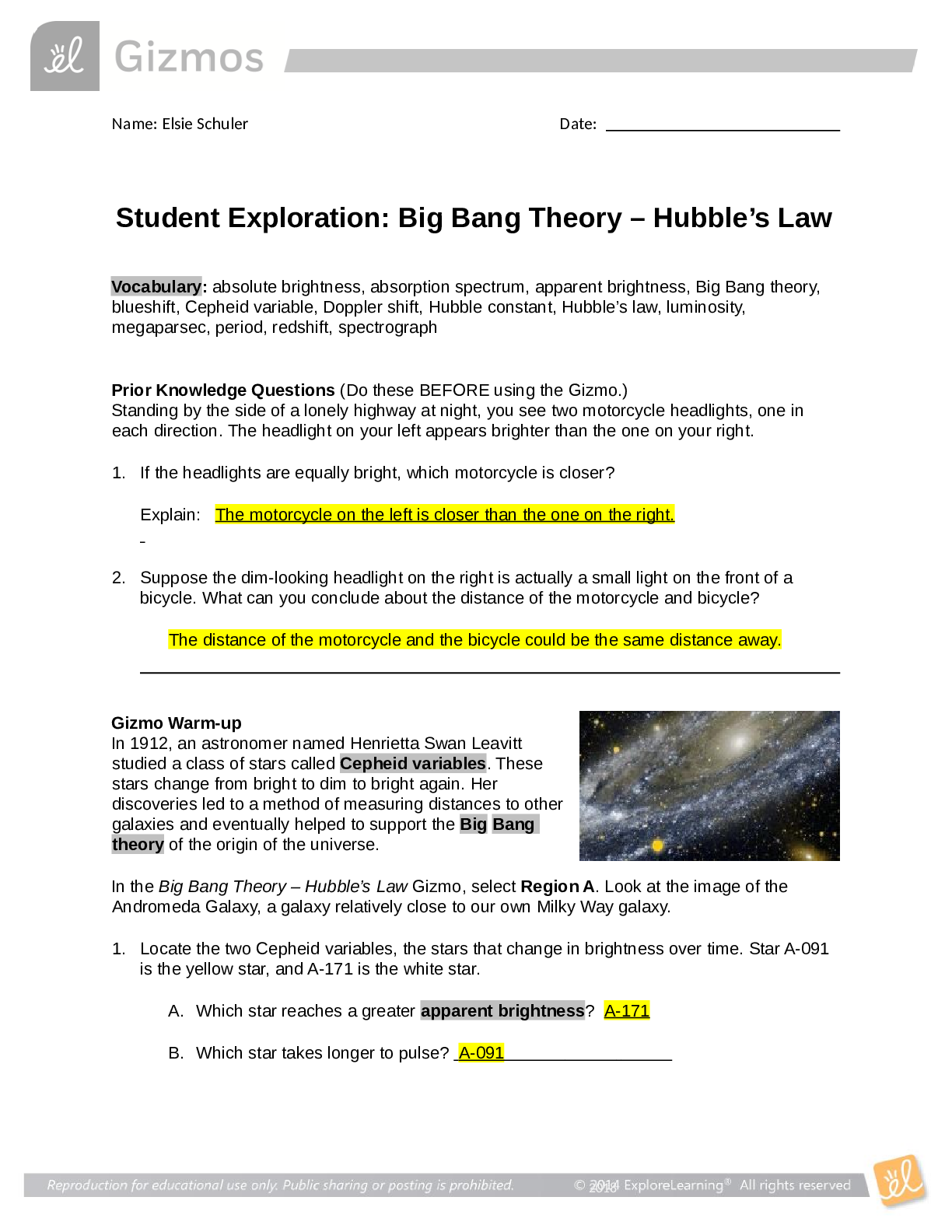Vocabulary: absolute brightness, absorption spectrum, apparent brightness, Big Bang theory,
blueshift, Cepheid variable, Doppler shift, Hubble constant, Hubble’s law, luminosity,
megaparsec, period, redshift, spectrograph
Prior Knowledge Questions (Do these BEFORE using the Gizmo.)
Standing by the side of a lonely highway at night, you see two motorcycle headlights, one in
each direction. The headlight on your left appears brighter than the one on your right.
1. If the headlights are equally bright, which motorcycle is closer?
Explain: The motorcycle on the left is closer than the one on the right.
2.Suppose the dim-looking headlight on the right is actually a small light on the front of a
bicycle. What can you conclude about the distance of the motorcycle and bicycle?
The distance of the motorcycle and the bicycle could be the same distance away.
Gizmo Warm-up
In 1912, an astronomer named Henrietta Swan Leavitt
studied a class of stars called Cepheid variables. These
stars change from bright to dim to bright again. Her
discoveries led to a method of measuring distances to other
galaxies and eventually helped to support the Big Bang
theory of the origin of the universe.
In the Big Bang Theory – Hubble’s Law Gizmo, select Region A. Look at the image of the
Andromeda Galaxy, a galaxy relatively close to our own Milky Way galaxy.
1. Locate the two Cepheid variables, the stars that change in brightness over time. Star A-091
is the yellow star, and A-171 is the white star.
A. Which star reaches a greater apparent brightness? A-171
B. Which star takes longer to pulse? A-091
2018
2.Because both stars are in the same galaxy, they are about the same distance from Earth.
Based on what you see, how is the brightness of the star related to how quickly it pulses?
It looks like the brighter the star – the closer it is or how big it is – the faster it pulses.
Activity A:
Period and
brightness
Get the Gizmo ready:
On the STARS tab, check that Region A: NGC
224 (Andromeda Galaxy) is selected. If not, click
Return to map and select Region A.
Introduction: Two factors determine how bright a star appears to an observer: its luminosity,
or absolute brightness, and its distance from the observer. A star may appear bright because it
is a large, luminous star, or because it is very close. It is only possible to use a star’s apparent
brightness to determine its distance if you know the star’s luminosity. Henrietta Leavitt’s work on
Cepheids provided the key to solving this problem.
Question: How do Cepheids allow astronomers to measure intergalactic distances?
1.Collect data: Locate and select the yellow Cepheid variable star (A-091) in the lower left
section of the Andromeda Galaxy. Click the Collect data button. You will see a graph of the
apparent brightness of the star over time.
A. How does the star’s apparent brightness change over time?
The stars brightness
increases in one day and then slowly decreases for about 10 days.
B. Turn on Show time probes. Set the left probe at the first brightness peak, and the
right probe at the second brightness peak. List the time represented by each probe:
Left probe time: 1.0 d
Right probe time: __13.0 d___
C. What is the time difference between the two brightness peaks? __12.0 d___
This is the period of the Cepheid.
D. In the DATA tab, record the name of this star and its period. Do the same on your
paper Data worksheet, located on the last page of this document.
2.Collect data: The apparent brightness of the star is shown on the y-axis of the graph. The
brightness is given as the ratio of the star’s brightness to the Sun’s brightness if viewed from
a standard distance of one megaparsec (1 Mpc), which is about 3.26 million light years. For
example, a brightness of “4,000” means that the star appears 4,000 times as bright as the
Sun would appear if observed from a distance of 1 Mpc.
A. What is your estimate of the mean apparent brightness of star A-091? 7000
Read More


